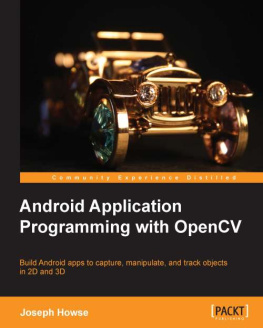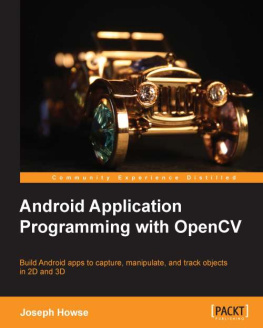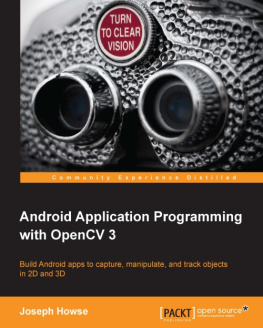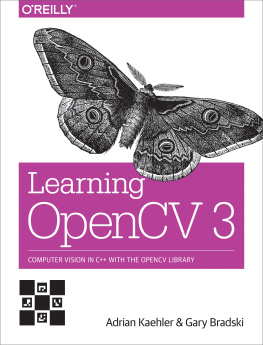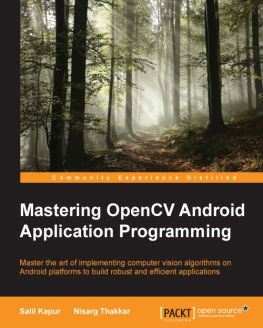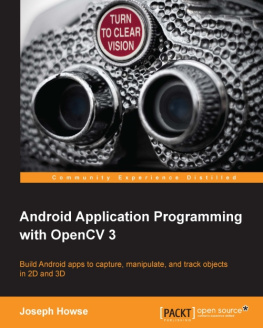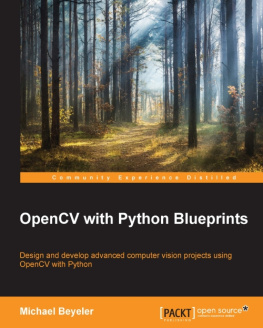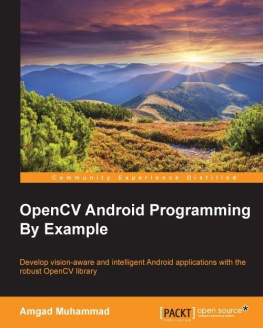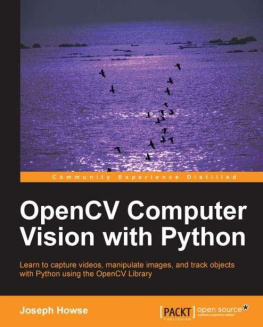Howse - Android application programming with OpenCV : build Android apps to capture, manipulate, and track objects in 2D and 3D
Here you can read online Howse - Android application programming with OpenCV : build Android apps to capture, manipulate, and track objects in 2D and 3D full text of the book (entire story) in english for free. Download pdf and epub, get meaning, cover and reviews about this ebook. City: Birmingham, UK, year: 2013, publisher: Packt Publishing, genre: Computer. Description of the work, (preface) as well as reviews are available. Best literature library LitArk.com created for fans of good reading and offers a wide selection of genres:
Romance novel
Science fiction
Adventure
Detective
Science
History
Home and family
Prose
Art
Politics
Computer
Non-fiction
Religion
Business
Children
Humor
Choose a favorite category and find really read worthwhile books. Enjoy immersion in the world of imagination, feel the emotions of the characters or learn something new for yourself, make an fascinating discovery.
Android application programming with OpenCV : build Android apps to capture, manipulate, and track objects in 2D and 3D: summary, description and annotation
We offer to read an annotation, description, summary or preface (depends on what the author of the book "Android application programming with OpenCV : build Android apps to capture, manipulate, and track objects in 2D and 3D" wrote himself). If you haven't found the necessary information about the book — write in the comments, we will try to find it.
Overview
- Set up OpenCV and an Android development environment on Windows, Mac, or Linux
- Capture and display real-time videos and still images
- Manipulate image data using OpenCV and Apache Commons Math
- Track objects and render 2D and 3D graphics on top of them
- Create a photo-capture and photo-sharing app that supports a variety of filters with a real-time preview feature
In Detail
Take a smartphone from your pocket, and within a few seconds, you can snap a photo, manipulate it, and share it with the world. You have just achieved mass production of image data. With a computer vision library such as OpenCV, you can analyze and transform copious amounts of image data in real time on a mobile device. The upshot to this is that you, as developers, can provide mobile users with many new kinds of images, constantly highlighting certain visual features that are of artistic or practical interest. Android is a convenient platform for such experiments because it uses a high-level language (Java), it provides standardized interfaces for sharing image data between applications, and it is mostly open source, so everyone can study its implementation.
Android Application Programming with OpenCV is a practical, hands-on guide that covers the fundamental tasks of computer visioncapturing, filtering, and analyzing images-with step-by-step instructions for writing both an application and reusable library classes.
Android Application Programming with OpenCV looks at OpenCVs Java bindings for Android and dispels mysteries such as which version of these bindings to use, how to integrate with standard Android functionality for layout, event handling, and data sharing, and how to integrate with OpenGL for rendering. By following the clear, concise, and modular examples provided in this book, you will develop an application that previews, captures, and shares photos with special effects based on color manipulation, edge detection, image tracking, and 3D rendering.Beneath the application layer, you will develop a small but extensible library that you can reuse in your future projects. This library will include filters for selectively modifying an image based on edge detection, 2D and 3D image trackers, and adapters to convert the Android systems camera specifications into OpenCV and OpenGL projection matrices. If you want a quick start in computer vision for Android, then this is the book for you.
By the end of Android Application Programming with OpenCV, you will have developed a computer vision application that integrates OpenCV, Android SDK, and OpenGL.
What you will learn from this book
- Install OpenCV and an Android development environment on Windows, Mac, or Linux
- Capture, display, and save images
- Make images accessible to other apps via Androids MediaStore and Intent classes
- Integrate OpenCV events and views with Androids standard activity lifecycle and view hierarchy
- Learn how OpenCV uses matrices to store data about images, recognizable features in images, and camera characteristics
- Apply curves and other color transformations to simulate the look of old photos, movies, or video games
- Apply convolution filters that sharpen, blur, emboss, or darken edges and textures in an image
- Track real-world objects, especially printed images, in 2D and 3D space
- Extract camera data from Android SDK and use it to construct OpenCV and OpenGL projection matrices
- Render basic 3D graphics in OpenGL
Howse: author's other books
Who wrote Android application programming with OpenCV : build Android apps to capture, manipulate, and track objects in 2D and 3D? Find out the surname, the name of the author of the book and a list of all author's works by series.

